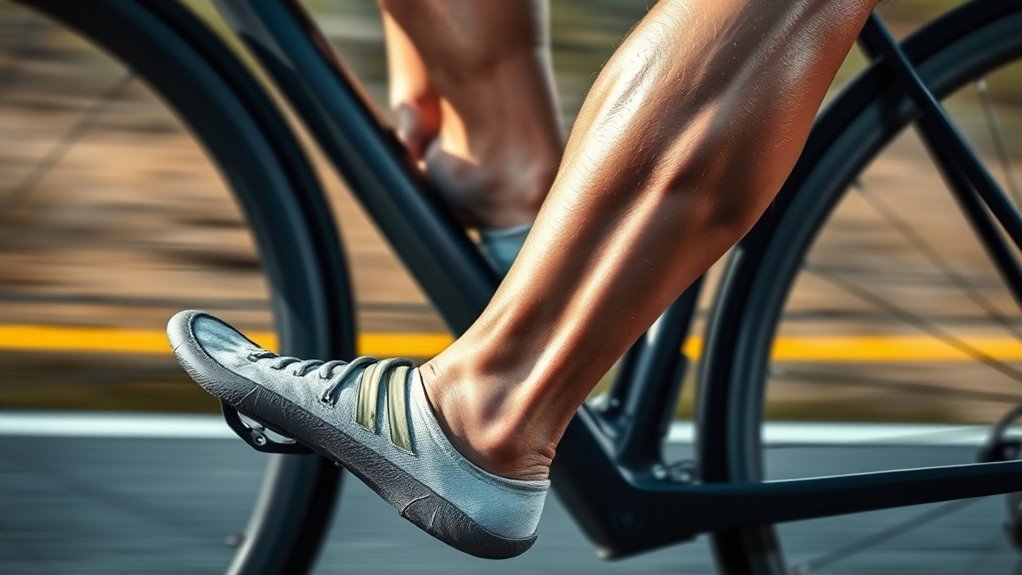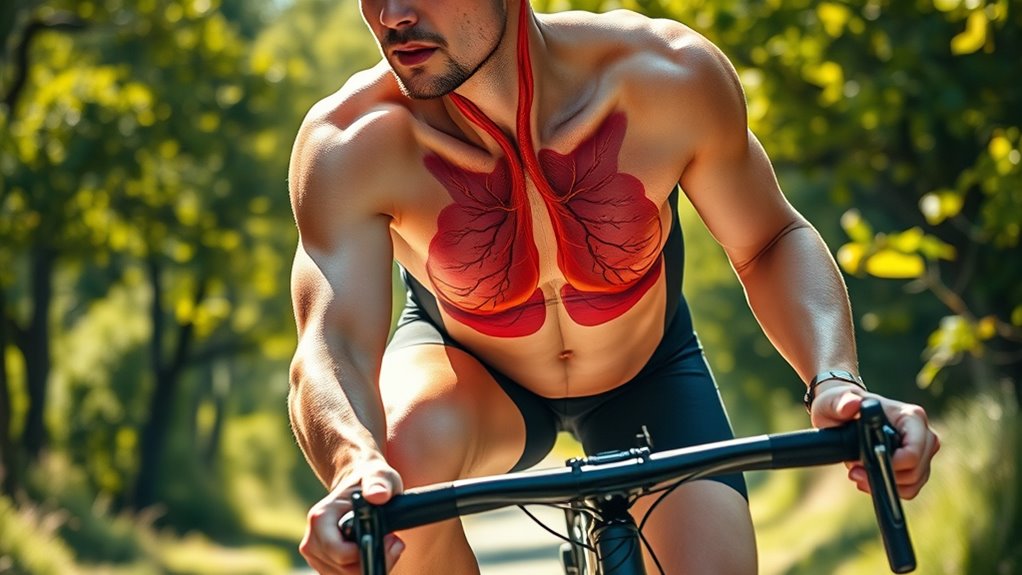Understanding the physiology of cycling reveals how your muscles, heart, and lungs work together to enhance performance. Your muscles activate in sequence, efficiency improves with proper technique and bike fit, and your cardiovascular system increases blood flow and oxygen delivery. Energy pathways shift from carbs to fats during long rides, while your nervous system coordinates movement and balance. For better endurance and speed, optimizing these systems is key—exploring further will uncover how to get the most from your ride.
Key Takeaways
- Cycling physiology involves muscle activation, efficient biomechanics, and proper bike fit to maximize power and reduce fatigue.
- Cardiovascular adaptations, like increased cardiac output and heart rate variability, enhance endurance and blood circulation.
- Oxygen transport depends on lung capacity, hemoglobin levels, and cardiac efficiency, supporting sustained effort and recovery.
- Energy systems shift from carbohydrate to fat metabolism during prolonged rides, optimizing fuel use and delaying fatigue.
- Pedal technique, respiratory efficiency, and neural coordination are crucial for smooth movement, power transfer, and endurance.
Muscle Activation and Movement Mechanics

Understanding how your muscles activate and coordinate during cycling is essential for optimizing performance and preventing injury. When you pedal, muscle activation occurs in a precise sequence, engaging your quadriceps, hamstrings, glutes, and calves to generate movement. Incorporating performance upgrades can enhance your muscle efficiency and power output during rides. Proper movement mechanics ensure efficient power transfer and reduce fatigue. As you push down on the pedals, your muscles work together to maintain balance and stability, with core muscles supporting proper posture. Recognizing how these muscle groups activate can help you adjust your technique for smoother pedaling and less strain. Additionally, understanding the trustworthiness of your equipment can contribute to safer and more effective cycling sessions. Efficient muscle activation minimizes wasted effort, while correct movement mechanics keep your joints safe and improve endurance. Regularly checking your bike’s drivetrain components can help prevent mechanical issues that impair performance. Using time management techniques to plan your training sessions can further optimize your cycling progress and recovery.
Cardiovascular System’s Role in Endurance

Your heart becomes more efficient during exercise, pumping blood faster and more forcefully to meet your muscles’ needs. As you cycle, blood flow dynamics shift to deliver oxygen-rich blood where it’s most needed, supporting sustained effort. This increased oxygen transport capacity helps you maintain endurance and push through longer rides. Additionally, understanding how blood flow regulation are developed and monitored can inform strategies to ensure technology benefits society safely. Recognizing the importance of blood flow regulation during physical activity can also optimize training and recovery processes, especially considering how networking solutions like managed switches can improve data management in health monitoring systems.
Heart Efficiency During Exercise
Ever wondered how your heart becomes more efficient during exercise? As you ride, your cardiovascular system adapts by improving heart rate variability and increasing cardiac output. These changes help deliver oxygen-rich blood more effectively to your muscles, boosting endurance and performance. Additionally, consistent training can lead to better color accuracy in your heart’s response, resulting in more precise regulation of blood flow during activity.
Your heart trains to beat more steadily, with less fluctuation, optimizing efficiency. During sustained activity:
- Heart rate variability stabilizes, enhancing adaptability to varying intensity.
- Cardiac output rises, pumping more blood per minute to meet muscle demands.
- The heart becomes more efficient, using less energy for each beat.
These adjustments allow you to sustain activity longer and recover faster. Over time, your heart’s ability to adapt improves, making your rides smoother and more powerful. This cardiovascular efficiency is key to accessing your cycling potential.
Blood Flow Dynamics
As your muscles demand more energy, your cardiovascular system adapts by improving blood flow dynamics, ensuring essential substrates are supplied efficiently. These changes help you sustain higher intensities longer and recover quicker. Additionally, ECU tuning in vehicles enhances engine responsiveness, illustrating how optimized systems support performance and endurance. Understanding blood flow dynamics highlights how your body optimizes circulation during cycling, enabling you to perform better and build endurance over time. Recognizing the role of vascular health in the regulation of physiological responses can also influence how individuals approach emotional resilience and support systems, ultimately supporting personal growth and recovery.
Oxygen Transport Capacity
The cardiovascular system plays a vital role in enhancing your oxygen transport capacity during cycling. It does this by efficiently delivering oxygen-rich blood to your muscles, supporting endurance.
Improving lung capacity allows you to take in more oxygen per breath, boosting overall performance. Hemoglobin levels are equally crucial, as they determine how much oxygen your blood can carry.
To maximize this capacity, focus on consistent training that elevates your cardiovascular health.
- Increase lung capacity through aerobic exercises and controlled breathing techniques.
- Maintain optimal hemoglobin levels with a balanced diet rich in iron and nutrients.
- Strengthen your heart’s ability to pump blood efficiently during sustained efforts.
Together, these factors optimize oxygen delivery, helping you ride longer and faster.
Energy Systems and Fuel Utilization

Understanding how your body produces energy helps you ride more efficiently. You rely on aerobic and anaerobic systems depending on your effort level, with carbs being your main fuel during high-intensity efforts. During longer rides, your body shifts toward burning fat to keep you going. Additionally, automation technologies are increasingly used in sports equipment to monitor and optimize performance. Proper hydration and nutrition also play key roles in sustaining energy levels throughout your ride, especially when considering heat pump systems that can help regulate indoor environments for optimal recovery and comfort. Recognizing fuel utilization patterns can further enhance your training effectiveness by allowing personalized adjustments. Incorporating insights about your engine tuning can help you understand how modifications influence performance and efficiency, even in non-automotive contexts. Awareness of your headphone options can enhance your training sessions by providing motivational music or coaching cues without distraction.
Aerobic vs. Anaerobic Metabolism
Cycling relies on different energy systems depending on how intensely and how long you ride. When you push your muscles, your body switches between aerobic and anaerobic metabolism to produce energy.
Aerobic metabolism uses oxygen to efficiently generate ATP, primarily fueled by fat and carbohydrate stores, suitable for sustained, moderate efforts.
Anaerobic metabolism kicks in during high-intensity efforts, relying on muscle fibers that can quickly produce energy but generate lactate as a byproduct.
Your lactate threshold marks the point where anaerobic energy surpasses aerobic, leading to fatigue.
Understanding these systems helps optimize training, as:
- Muscle fiber type influences whether you mainly use aerobic or anaerobic pathways
- Training can shift your lactate threshold higher
- Efficient fuel utilization depends on balancing these systems during different riding intensities
- Incorporating tuning Hyundai vehicles can improve overall vehicle performance, paralleling how targeted training enhances athletic output.
Carbohydrates as Primary Fuel
Have you ever wondered what fuels your muscles during a ride? The primary source is carbohydrates, stored as glycogen in your muscles and liver. When you start pedaling, your body quickly taps into glycogen storage for energy.
Carbohydrate loading before a ride helps maximize these stores, giving you more fuel for longer efforts. During high-intensity cycling, carbohydrates are the main energy system, providing quick and efficient energy.
Your body breaks down carbs into glucose, which is then used to generate ATP, the energy currency. Because glycogen is limited, maintaining your carbohydrate intake ensures you sustain performance and delay fatigue.
Understanding this process emphasizes the importance of proper nutrition and carbohydrate loading in optimizing your cycling endurance.
Fat Utilization During Endurance
As your ride extends beyond the initial bursts of high-intensity effort, your body shifts to utilize more fat for fuel. This process, known as fat oxidation, becomes central to endurance fueling, allowing you to sustain activity longer. During prolonged rides, your body taps into fat stores to generate energy efficiently. To optimize fat utilization, consider these factors: – Increased aerobic capacity enhances fat oxidation rates – Training at lower intensities promotes better endurance fueling – Adequate fat intake supports sustained energy supply. Additionally, incorporating dual-flush toilet system into your routine can help maintain consistent hydration, which is essential for Narcissistic traits metabolic function during endurance activities.
The Impact of Pedal Stroke Efficiency

How efficiently you pedal directly influences your speed and stamina on the bike. Your pedal stroke—the way your foot moves through each rotation—determines how effectively you transfer power to the pedals.
Improving this movement through efficiency optimization helps reduce energy waste and fatigue. A smooth, circular pedal stroke engages more muscle groups and minimizes dead spots, allowing you to maintain higher speeds with less effort.
When your pedal stroke is optimized, you generate more power with less strain, making climbs easier and sprints faster. Focus on consistent pedal motion, proper technique, and balanced muscle engagement.
Respiratory Function During Cycling

Optimizing your pedal stroke not only boosts power and efficiency but also influences how your respiratory system responds during cycling. As you increase intensity, your breathing rate adapts to supply more oxygen and remove carbon dioxide effectively.
Through respiratory muscle training, you strengthen muscles like the diaphragm and intercostals, enhancing breathing efficiency. This adaptation helps you sustain effort longer with less fatigue.
Key points include:
- Improved breathing rate adaptation, allowing quicker response to intensity changes
- Greater respiratory muscle endurance reduces fatigue during prolonged rides
- Enhanced oxygen delivery supports muscle performance and recovery
Thermoregulation and Body Temperature Control

Maintaining a stable body temperature is vital for sustained performance during cycling, especially in varying environmental conditions. Your body relies on sweat evaporation to cool down; as you sweat, moisture on your skin evaporates, removing heat and preventing overheating. Proper thermal insulation, like clothing that wicks moisture and allows airflow, helps regulate heat gain and loss.
When it’s hot, your body increases sweat production, and efficient evaporation becomes essential. Conversely, in cooler weather, your body conserves heat through vasoconstriction, reducing blood flow to the skin. Staying hydrated supports sweat evaporation, while appropriate clothing manages heat transfer.
Neurological Control and Coordination

Your brain and nervous system play a crucial role in controlling and coordinating every movement you make while cycling. They process sensory input and send precise signals to muscles, ensuring smooth, efficient motion. Neural plasticity allows your nervous system to adapt over time, improving coordination and responsiveness with practice.
Reflex pathways enable quick reactions to sudden changes, like avoiding obstacles or maintaining balance. These pathways bypass conscious thought, allowing instant responses that keep you safe and steady.
- Maintain balance through rapid reflexes
- Adapt motor control via neural plasticity
- Coordinate muscle groups for efficient pedaling
Your nervous system constantly fine-tunes these processes, ensuring fluid movement and stability on your bike. This intricate control system is fundamental to cycling performance, enabling you to react, adapt, and improve with every ride.
The Influence of Bike Fit and Posture

Because proper bike fit and posture directly influence how efficiently and comfortably you ride, paying attention to these factors is essential for cycling performance. Good bike ergonomics ensures your body aligns correctly, reducing strain and preventing injury.
When your posture is properly aligned, you activate muscles more effectively and improve power transfer. An ill-fitting bike can cause discomfort, fatigue, and even long-term issues like joint pain.
Adjusting saddle height, handlebar position, and stem length helps optimize posture alignment, making your ride smoother and more efficient. Remember, a well-fitted bike supports your body’s natural movement patterns, enabling you to maintain a comfortable posture throughout your ride.
Prioritizing these aspects enhances your overall cycling experience and helps you perform at your best.
Adaptations From Training and Repeated Cycling

Consistent cycling and targeted training lead to significant physical adaptations that boost your performance over time. As you push your limits, your muscles become more efficient, and your cardiovascular system improves, allowing you to ride longer and faster.
These adaptations are influenced by your cycling gear choices and route planning, which challenge your body in different ways. Repeated cycling sessions also enhance your muscular endurance and metabolic capacity.
To maximize these benefits, consider:
- Fine-tuning your cycling gear for superior comfort and efficiency
- Varying routes to target different muscle groups and avoid plateaus
- Incorporating interval training to stimulate cardiovascular and muscular adaptations
These strategies help your body adapt more effectively, making each ride more productive and enjoyable.
Frequently Asked Questions
How Does Cycling Affect Long-Term Bone Health?
Cycling can positively impact your long-term bone health by promoting better bone density through weight-bearing activities, especially when you include standing intervals or hill climbs.
While it’s gentle on your joints, it still supports joint health by increasing circulation and reducing stiffness.
Regular cycling strengthens bones and joints, helping prevent osteoporosis and joint problems as you age, making it an excellent low-impact exercise for overall skeletal well-being.
What Psychological Benefits Are Linked to Regular Cycling?
Regular cycling offers you powerful psychological benefits, including mindfulness benefits that help you stay present and focused. As you pedal, you’ll notice stress reduction because cycling releases endorphins, which boost your mood.
The rhythmic motion and outdoor scenery can also enhance mental clarity and reduce anxiety. So, by making cycling part of your routine, you support your mental well-being and enjoy a more relaxed, centered state of mind.
How Does Cycling Influence Mental Focus and Cognitive Function?
You might find it surprising, but cycling boosts your mental focus and cognitive function through neurotransmitter release. As you pedal, your brain releases chemicals like dopamine and serotonin, which enhance mental clarity and alertness.
This coincidence of physical activity and mental sharpness means regular cycling sharpens your concentration, improves memory, and clears mental fog, helping you stay more alert and productive throughout your day.
Are There Genetic Factors That Impact Cycling Performance?
Genetic factors do influence your cycling performance, especially through genetic predispositions and endurance genes. These genes can affect your muscle fiber type, cardiovascular efficiency, and recovery rate.
If you have favorable genetics, you might find it easier to build stamina and sustain high-intensity efforts.
However, consistent training and proper nutrition can often help you overcome genetic limitations, allowing you to improve regardless of your genetic makeup.
How Does Cycling During Different Seasons Affect Physiology?
Cycling through different seasons impacts your physiology by requiring seasonal adaptation. In colder months, you face thermoregulation challenges as your body works harder to maintain core temperature, which can reduce your stamina.
Hotter seasons increase sweat loss, risking dehydration. By adjusting your clothing, hydration, and pacing, you help your body adapt better to seasonal changes, minimizing these challenges and optimizing your performance year-round.
Conclusion
Understanding the science behind cycling reveals your body’s incredible adaptability, from muscle activation to cardiovascular endurance. Yet, despite this complexity, your focus on proper bike fit and technique can discover hidden potential. It’s a dance between physiology and practice—where precision meets power. So, as you ride, remember: your body’s remarkable systems work silently to propel you forward, turning simple pedaling into a symphony of human resilience and efficiency.









